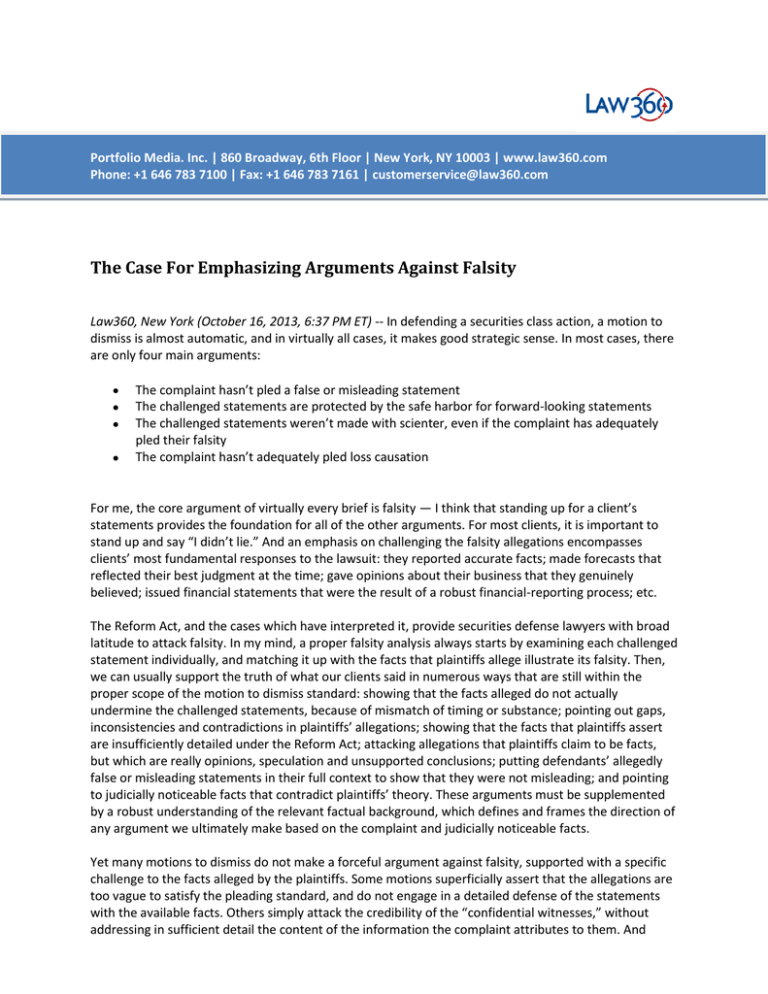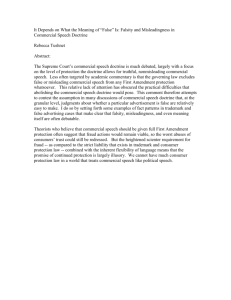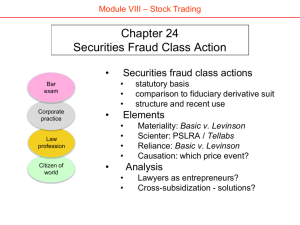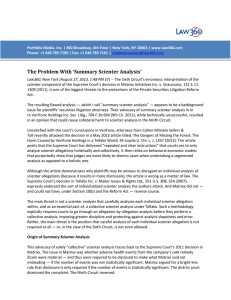Portfolio Media. Inc. | 860 Broadway, 6th Floor | New... Phone: +1 646 783 7100 | Fax: +1 646 783...
advertisement

Portfolio Media. Inc. | 860 Broadway, 6th Floor | New York, NY 10003 | www.law360.com Phone: +1 646 783 7100 | Fax: +1 646 783 7161 | customerservice@law360.com The Case For Emphasizing Arguments Against Falsity Law360, New York (October 16, 2013, 6:37 PM ET) -- In defending a securities class action, a motion to dismiss is almost automatic, and in virtually all cases, it makes good strategic sense. In most cases, there are only four main arguments: The complaint hasn’t pled a false or misleading statement The challenged statements are protected by the safe harbor for forward-looking statements The challenged statements weren’t made with scienter, even if the complaint has adequately pled their falsity The complaint hasn’t adequately pled loss causation For me, the core argument of virtually every brief is falsity — I think that standing up for a client’s statements provides the foundation for all of the other arguments. For most clients, it is important to stand up and say “I didn’t lie.” And an emphasis on challenging the falsity allegations encompasses clients’ most fundamental responses to the lawsuit: they reported accurate facts; made forecasts that reflected their best judgment at the time; gave opinions about their business that they genuinely believed; issued financial statements that were the result of a robust financial-reporting process; etc. The Reform Act, and the cases which have interpreted it, provide securities defense lawyers with broad latitude to attack falsity. In my mind, a proper falsity analysis always starts by examining each challenged statement individually, and matching it up with the facts that plaintiffs allege illustrate its falsity. Then, we can usually support the truth of what our clients said in numerous ways that are still within the proper scope of the motion to dismiss standard: showing that the facts alleged do not actually undermine the challenged statements, because of mismatch of timing or substance; pointing out gaps, inconsistencies and contradictions in plaintiffs’ allegations; showing that the facts that plaintiffs assert are insufficiently detailed under the Reform Act; attacking allegations that plaintiffs claim to be facts, but which are really opinions, speculation and unsupported conclusions; putting defendants’ allegedly false or misleading statements in their full context to show that they were not misleading; and pointing to judicially noticeable facts that contradict plaintiffs’ theory. These arguments must be supplemented by a robust understanding of the relevant factual background, which defines and frames the direction of any argument we ultimately make based on the complaint and judicially noticeable facts. Yet many motions to dismiss do not make a forceful argument against falsity, supported with a specific challenge to the facts alleged by the plaintiffs. Some motions superficially assert that the allegations are too vague to satisfy the pleading standard, and do not engage in a detailed defense of the statements with the available facts. Others simply attack the credibility of the “confidential witnesses,” without addressing in sufficient detail the content of the information the complaint attributes to them. And others fall back on the doctrine of “puffery,” which posits that even if false, the challenged statements were immaterial.[1] By focusing on these and similar approaches, a brief may leave the judge with the impression that defendants concede falsity, and that the real defense is that the false statements were not made with scienter. That’s risky. It’s risky for several reasons. First, detailed, substantive arguments against falsity are some of the strongest arguments that defendants can make. Second, those arguments provide the foundation for the rest of the motion. The exclusion of a strong falsity argument weakens the argument against scienter, and fails to paint the best possible no-fraud picture for the judge — which is ultimately what helps a judge to be comfortable in granting a motion to dismiss. Failing to Emphasize the Falsity Argument Weakens the Scienter Argument The element of scienter requires a plaintiff to demonstrate that the defendant said something knowingly or recklessly false — in order to do this, plaintiffs must tie their scienter allegations to each particular challenged statement. It is not enough to generally allege, as plaintiffs often do, that defendants had a general “motive to lie.” When I analyze scienter allegations, I ask myself, “scienter as to what?” Asking this question often unlocks strong arguments against scienter, because complaints often make scienter allegations that are largely detached from their allegations of falsity. Often, this is the case because the falsity allegations are insufficient to begin with. But many motions to dismiss are unable to point out this lack of connection, because they don’t focus on falsity in a rigorous and thorough way. Focusing on falsity also is necessary because of how courts analyze falsity and scienter. Although falsity and scienter are separate elements — and should be analyzed separately — courts often analyze them together. See, e.g., Ronconi v. Larkin, 253 F.3d 423, 429 (9th Cir. 2001) (“Because falsity and scienter in private securities fraud cases are generally strongly inferred from the same set of facts, we have incorporated the dual pleading requirements of 15 U.S.C. §§ 78u-4(b)(1) and (b)(2) into a single inquiry.”). Arguing a lack of falsity thus provides essential ingredients for this combined analysis. Even when courts analyze falsity and scienter separately, a proper scienter analysis requires a foundational falsity analysis, because as noted above, scienter analysis asks whether the defendant knew that a particular statement was false. Without an understanding of exactly why that challenged statement was false, and what facts allegedly demonstrate that falsity, the scienter analysis meanders, devolving into an analysis of knowledge of facts that may or may not be probative of the speaker’s state of mind related to that statement. The tendency to lump scienter and falsity together is exemplified by the scienter doctrines that I call “scienter shortcuts:” (1) the corporate scienter doctrine (see, e.g., Teamsters Local 445 Freight Division Pension Fund v. Dynex Capital Inc., 531 F.3d 190, 195-96 (2d Cir. 2008) and Makor Issues & Rights Ltd. v. Tellabs Inc., 513 F.3d 702 (7th Cir. 2008)), and (2) the core operations inference of scienter (see, e.g., Glazer Capital Management LP v. Magistri, 549 F.3d 736 (9th Cir. 2008)). Under these doctrines, courts draw inferences about what the defendants knew based upon the prominence of the falsity allegations. The more blatant the falsity, the more likely courts are to infer scienter. A superficial falsity argument weakens defendants’ ability to attack these scienter shortcuts, which plaintiffs are asserting more and more routinely. Failing to Emphasize the Falsity Argument Fails to Paint the Best Possible No-Fraud Picture for the Judge I contend that it is a good strategy for a defendant to thoroughly argue lack of falsity, even if there are better alternative grounds for dismissal, and even if the challenge to falsity is unlikely to be successful as an independent grounds for dismissal. This is for the simple reason that judges are humans — they will feel better about dismissing a case based on other grounds if you can make them feel comfortable that there was not a false statement to begin with. For example, courts are often reluctant to dismiss a complaint solely on safe harbor grounds because it is seen as a “license to lie,” so it is strategically wise also to argue that forward-looking statements were not false in the first place. Similarly, even if lack of scienter is the best basis for dismissal, it is good strategy to defend on the basis that no one said anything wrong, rather than appearing to concede falsity and being left to contend, “but they didn’t mean to.” Judges have enough latitude under the pleading standards to dismiss or not, in most cases. The pivotal “fact” is, in my opinion, whether the judge feels the case is really a fraud case, or not. A motion to dismiss that vigorously defends the truth of what the defendants said is more likely to make the judge feel that there really is no fraud there. Conversely, if defendants make an argument that essentially concedes falsity and relies solely on the argument that the falsity was immaterial, wasn’t intentional, or is not subject to challenge under the safe harbor, a judge may stretch to find a way to allow the case to continue. Put simply, a judge is more likely to dismiss a case in which a defendant says “I didn’t lie,” than when defendants argue that “I may have lied, but I didn’t mean to,” or “I may have lied, but it doesn’t matter,” or “I may have lied, but the law protects me anyway.” Even when a complaint might ultimately be dismissed on other grounds, I think that a strong challenge to falsity is essential to help the judge feel that he or she has reached a just result. —By Douglas W. Greene, Lane Powell PC Doug Greene is a shareholder in Lane Powell’s Seattle office and co-chairman of the firm’s securities litigation group. This article first appeared in Lane Powell's blog, D&O Discourse. The opinions expressed are those of the author and do not necessarily reflect the views of the firm, its clients, or Portfolio Media Inc., or any of its or their respective affiliates. This article is for general information purposes and is not intended to be and should not be taken as legal advice. [1] Many statements that defense counsel argue are “puffery” are really statements of opinion that could and should be analyzed under the standard that originated in theU.S. Supreme Court’s Virginia Bankshares decision: in order to adequately allege that a statement of opinion is false or misleading, a plaintiff must plead with particularity not only that the opinion was “objectively” false or misleading, but also that it was “subjectively” false or misleading, meaning that the opinion was not sincerely held by the speaker. My partner Claire Davis recently published a discussion of statements of opinion. All Content © 2003-2013, Portfolio Media, Inc.


